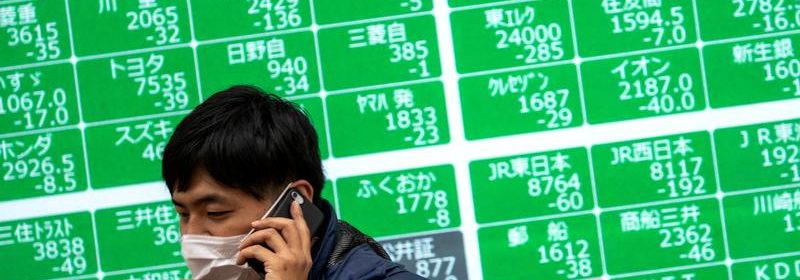Asian shares steady, dollar weak as traders await earnings

HONG KONG (Reuters) – Asian shares started steady on Monday ahead of a week packed with major quarterly earnings announcements, while the dollar hovered near October lows after three weeks of risk-friendly sentiment hurt safe-haven currencies.
HSBC and Facebook will both publish quarterly results on Monday, in Asian trading and late U.S. hours respectively.
Later in the week will be the turn of other benchmark heavyweights including tech giants Microsoft , Apple and Alphabet, and European and Asian financial behemoths from Deutsche Bank and Lloyds to China Construction Bank and Nomura.
“This week earnings take centre stage,” said Chris Weston, head of research at brokerage Pepperstone in Melbourne, in a morning note.
The results will be closely watched after a strong start to the U.S. earnings season for many companies, especially financials, helped both the Dow Jones Industrial Average and the S&P 500 touch record highs last week, though the Nasdaq fell on Friday after Snap and Intel Corp’s quarterly results disappointed.
MSCI’s broadest index of Asia-Pacific shares outside Japan has also posted gains in the past three weeks, which if it can hold onto them this week, would make October the benchmark’s best month of 2022.
On Monday morning, the regional benchmark was flat with a 0.5% gain in Australia balanced by a 0.6% fall in Korea.
Japan’s Nikkei lost 1% and U.S. S&P 500 futures shed 0.18%.
Asian shares have largely lagged their U.S. and European counterparts in recent months mainly due to regulatory ructions and fears of slowing growth in China.
In the latest announcement to worry some investors, the top decision-making body of the Chinese parliament said on Saturday it will roll out a pilot real estate tax in some regions.
Analysts at Citi summed up the announcement as an “earlier than expected trial but later than expected national rollout; no devastating impact.”
However, the risk friendlier mood that supported equities has weighed on safe-haven currencies, as have rising energy prices which supported currencies like the Aussie and Canadian dollars.
The dollar index was last at 93.667, hovering near its month low of 93.455 hit last week, and well off mid-October’s 12-month high.
However, analysts at CBA said it was more likely the dollar would rise than fall from here.
“Dollar risks remain skewed to the upside,” they wrote in a note citing rising expectations of inflation from markets, consumers and policy makers, meaning markets are pricing a more aggressive programme of interest rate hikes, which would support the dollar.
Markets are still trying to position themselves for a widely expected tapering of the U.S. stimulus programme this year, and the possibility of rate hikes late in 2022
Federal Reserve Chair Jerome Powell on Friday said the U.S. central bank should start the process of reducing its support of the economy by cutting back on its asset purchases, but should not yet touch interest rates.
As tapering looms, U.S. benchmark yields have been rising and yields on 10-year Treasury notes hit a five-month high of 1.7064% last week. In early Asia they were last 1.6465%.
Oil prices stayed elevated but just off recent multi-year peaks. Brent crude >LCOc1> rose 0.13% to $85.65 a barrel, while U.S. crude rose 0.38% to $84.08 a barrel.
Spot gold rose 0.06% to $1793.4 an ounce after posting gains for the past two weeks on rising inflation concerns.
Bitcoin another asset oft-described as an inflation hedge was last at $61,080 after a turbulent week when it hit a new high of $67,016.
Source: Read Full Article
